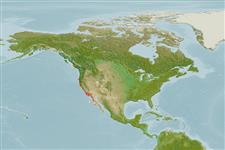Actinopterygii (ray-finned fishes) >
Perciformes (Perch-likes) >
Clinidae (Clinids)
Etymology: metzi: Named after W.P. Gibbons, an early naturalist from Alameda, California and C.W. Metz, perceptive student of the genus Gibbonsia (Ref. 6885, 27436). More on author: Hubbs.
Environment / Climate / Range
Ecology
Marine; demersal; depth range 0 - 9 m (Ref. 2850). Subtropical, preferred ?; 51°N - 27°N, 129°W - 114°W
Eastern Pacific: Vancouver Island, British Columbia, Canada to central Baja California, Mexico.
Size / Weight / Age
Maturity: Lm ? range ? - ? cm
Max length : 24.0 cm TL male/unsexed; (Ref. 2850)
Short description
Morphology | Morphometrics
Found among seaweeds, especially in tide pools and kelp.
Life cycle and mating behavior
Maturity | Reproduction | Spawning | Eggs | Fecundity | Larvae
Eschmeyer, W.N., E.S. Herald and H. Hammann, 1983. A field guide to Pacific coast fishes of North America. Boston (MA, USA): Houghton Mifflin Company. xii+336 p. (Ref. 2850)
IUCN Red List Status (Ref. 115185)
CITES (Ref. 94142)
Not Evaluated
Threat to humans
Harmless
Human uses
Aquarium: commercial
More information
Age/SizeGrowthLength-weightLength-lengthLength-frequenciesMorphometricsMorphologyLarvaeLarval dynamicsRecruitmentAbundance
ReferencesAquacultureAquaculture profileStrainsGeneticsAllele frequenciesHeritabilityDiseasesProcessingMass conversion
Tools
Special reports
Download XML
Internet sources
Estimates of some properties based on models
Phylogenetic diversity index (Ref.
82805): PD
50 = 0.6250 [Uniqueness, from 0.5 = low to 2.0 = high].
Bayesian length-weight: a=0.00513 (0.00219 - 0.01203), b=3.07 (2.86 - 3.28), in cm Total Length, based on LWR estimates for this (Sub)family-body shape (Ref.
93245).
Trophic Level (Ref.
69278): 3.4 ±0.4 se; Based on diet studies.
Resilience (Ref.
69278): .
Vulnerability (Ref.
59153): Low vulnerability (13 of 100) .
